Guildhall Art Gallery
A visit into the City of London on Friday brought me to the Guildhall Art Gallery. I find this area like another world, I rarely step foot in this part of London, so my knowledge of the area is pretty limited. I love the hustle and bustle Monday to Fridays, and how everything suddenly closes down as the weekend hits. I love the self importance, the wealth, the pretentiousness - the urgency of every person on the street - I stick out like a sore thumb!

So after a short walk from St Pauls, I walk up Queen Street and onto King Street, and come face to face with the Great Hall, with the Art Gallery on the right.
The Guildhall Art Gallery isn't very high up on many tourists list of places to visit very, so I'm guessing it doesn't get overly busy, and with it also being free - I would recommend it for a leisurely stroll around for an hour or so. It's open every day (Mon - Sat 10am - 5pm, Sun - 12pm - 4pm), so there's no real need to plan ahead.
The Art Gallery was established in 1886, as a collection of Art Treasures of the City of London. It's situated in a building that was destroyed in the Blitz (1941) and was re-opened in 1999, still in keeping with the neighbouring Guildhall with its semi - gothic exterior. It shows work from 1670 to the present, with examples from Victorian paintings, Pre-Raphaelite masterpieces, modern London sketches, and also a Roman Amphitheatre. It also holds some temporary exhibitions throughout the year (at a price) but check before going to see if there's anything you might be interested in. The gallery has a display of around 250 pieces at any one time, but has a full collection of 4,000 works so all the art you see is on rotation, so definitely an excuse to re-visit.
From John Constable, Dante Gabriel Rossetti, John Singleton Copley, to this Panorama of London in 1600 by Claese Van Visscher

At 2 metres long, it shows an imagined view of London before the Great Fire in 1666, from a viewpoint on the south bank of the River Thames. Things to look out for; St Pauls Cathedral without its spire after it was hit by lightening in 1561, London Bridge with its shops and houses on, the Globe Theatre, the Tower of London, Harrow on the Hill, Hampstead. But there are a few mistakes too! Apparently Claese never visited London, so it was based on maps, drawings and plans which he was able to get his hands on.
And right next to it is the Robin Reynolds interpretation, a modern day panoroma of the London landscape.
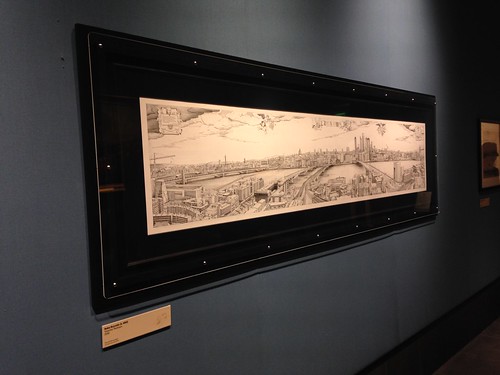
There's a bit of fun to have with this one, not only is it absolutely amazing image of London, but to collaborate with Shakespeare 400th anniversary, Robin has included references to Shakespeare most famous works. Apparently there's 37 plays, 3 poems and the sonnets. It's a bit addictive, but fortunately I standing next to someone who seemed to know a lot about this sketch, and I overheard him point out quite a few! My favourite one was "exit, pursued by a bear" (look out for the police boat called Pooh!) Theres a challenge to find all 41 apparently, so if your feeling pretty confident make sure you go along, it's only on display until November.
Some other pieces of interest;
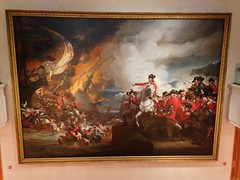
The Defeat of the Floating Batteries at Gibraltar by John Singleton Copley
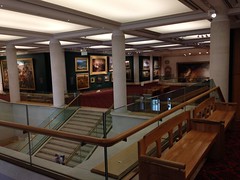
A large, spacious, quiet art gallery found right in the city
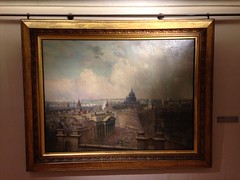
The Heart of the Empire by Neils Moller Lund
The Roman Amphitheatre
Step back in time, and visit the remains of the Roman Amphitheatre, right underneath the City of London. They were discovered during the redevelopment of the Guildhall Art Gallery in 1985. Around 43AD the Romans established Londinum, and within 30 years of settlement, it's believed that they constructed a wooden amphitheatre, able to seat more than 7,000 spectators. It was then redeveloped in the early 2nd century from stone, which is now on display underneath the Galleries. As with Rome, it was used to watch wild animal fights, executions of criminals, and of course Gladiator fights. The remains


St Lawrence Jewry
I also took the chance to visit the neighbouring church. This church was built after the Great Fire of London, and is a great piece of architecture from Sir Christoper Wren.
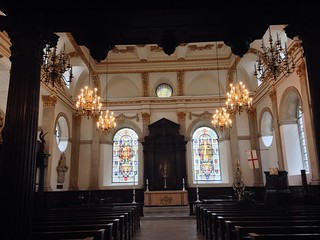
Also in the courtyard you can find;
- Guildhall Library - host exhibitions, guided walks, talks etc.
- Guildhall Great Hall - have a look round the City's only secular Medieval building (1411).
- The City Centre - you can learn about the Square Mile, its heritage and information right through to the present day.

So after a short walk from St Pauls, I walk up Queen Street and onto King Street, and come face to face with the Great Hall, with the Art Gallery on the right.
The Guildhall Art Gallery isn't very high up on many tourists list of places to visit very, so I'm guessing it doesn't get overly busy, and with it also being free - I would recommend it for a leisurely stroll around for an hour or so. It's open every day (Mon - Sat 10am - 5pm, Sun - 12pm - 4pm), so there's no real need to plan ahead.
The Art Gallery was established in 1886, as a collection of Art Treasures of the City of London. It's situated in a building that was destroyed in the Blitz (1941) and was re-opened in 1999, still in keeping with the neighbouring Guildhall with its semi - gothic exterior. It shows work from 1670 to the present, with examples from Victorian paintings, Pre-Raphaelite masterpieces, modern London sketches, and also a Roman Amphitheatre. It also holds some temporary exhibitions throughout the year (at a price) but check before going to see if there's anything you might be interested in. The gallery has a display of around 250 pieces at any one time, but has a full collection of 4,000 works so all the art you see is on rotation, so definitely an excuse to re-visit.
From John Constable, Dante Gabriel Rossetti, John Singleton Copley, to this Panorama of London in 1600 by Claese Van Visscher

At 2 metres long, it shows an imagined view of London before the Great Fire in 1666, from a viewpoint on the south bank of the River Thames. Things to look out for; St Pauls Cathedral without its spire after it was hit by lightening in 1561, London Bridge with its shops and houses on, the Globe Theatre, the Tower of London, Harrow on the Hill, Hampstead. But there are a few mistakes too! Apparently Claese never visited London, so it was based on maps, drawings and plans which he was able to get his hands on.
And right next to it is the Robin Reynolds interpretation, a modern day panoroma of the London landscape.

There's a bit of fun to have with this one, not only is it absolutely amazing image of London, but to collaborate with Shakespeare 400th anniversary, Robin has included references to Shakespeare most famous works. Apparently there's 37 plays, 3 poems and the sonnets. It's a bit addictive, but fortunately I standing next to someone who seemed to know a lot about this sketch, and I overheard him point out quite a few! My favourite one was "exit, pursued by a bear" (look out for the police boat called Pooh!) Theres a challenge to find all 41 apparently, so if your feeling pretty confident make sure you go along, it's only on display until November.
Some other pieces of interest;

The Defeat of the Floating Batteries at Gibraltar by John Singleton Copley

A large, spacious, quiet art gallery found right in the city

The Heart of the Empire by Neils Moller Lund
The Roman Amphitheatre
Step back in time, and visit the remains of the Roman Amphitheatre, right underneath the City of London. They were discovered during the redevelopment of the Guildhall Art Gallery in 1985. Around 43AD the Romans established Londinum, and within 30 years of settlement, it's believed that they constructed a wooden amphitheatre, able to seat more than 7,000 spectators. It was then redeveloped in the early 2nd century from stone, which is now on display underneath the Galleries. As with Rome, it was used to watch wild animal fights, executions of criminals, and of course Gladiator fights. The remains


St Lawrence Jewry
I also took the chance to visit the neighbouring church. This church was built after the Great Fire of London, and is a great piece of architecture from Sir Christoper Wren.

Also in the courtyard you can find;
- Guildhall Library - host exhibitions, guided walks, talks etc.
- Guildhall Great Hall - have a look round the City's only secular Medieval building (1411).
- The City Centre - you can learn about the Square Mile, its heritage and information right through to the present day.
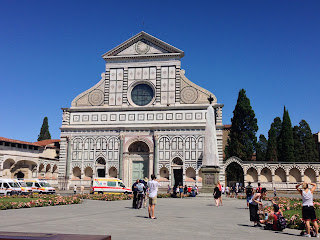
Comments
Post a Comment